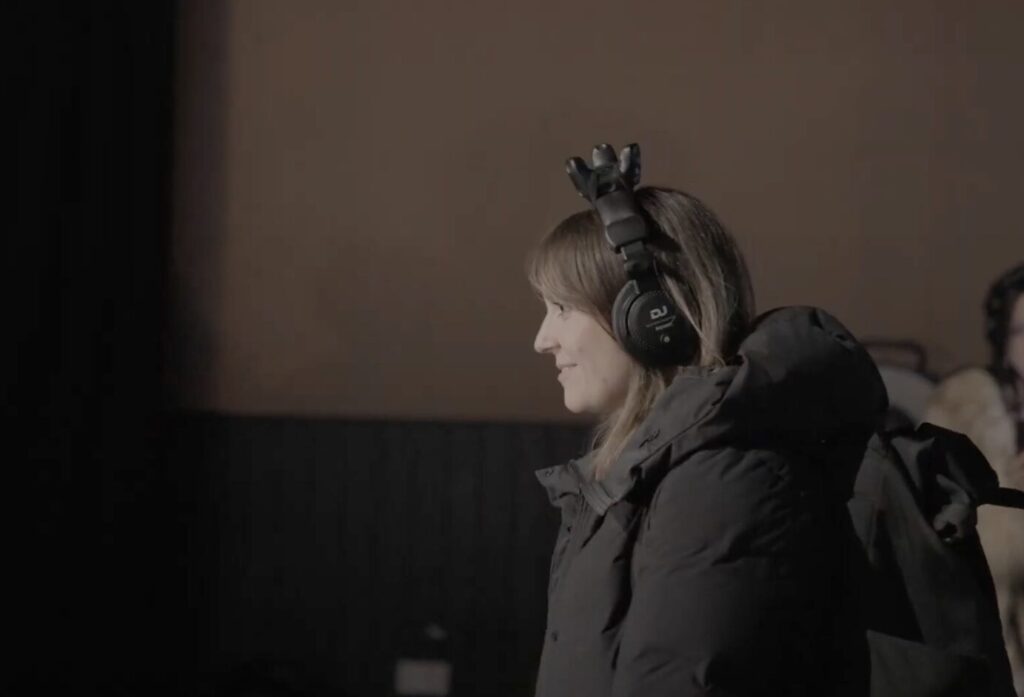
Unwired Dance Theatre’s Where We Meet is an interactive and immersive dance theatre performance where you’re in control of revealing the hidden stories behind each character.
Uniquely, audience members are provided with an interactive audio headset that gives the gift of telepathy, enabling them to tune into the vibrant inner monologues of whichever character they’re closest to.
Ahead of the show’s run at The Cockpit, we caught up with the company’s Artistic Director to find out more about their approach.
Q&A with Clemence Debaig, Artistic Director of Unwired Dance Theatre
What can you tell us about Where We Meet?
Where We Meet is a joyful and communal experience made possible through innovative technology that allows the audience to access the inner thoughts of the characters. Our starting point was that we can never really know what is happening in someone’s mind and we wanted to give access to those inner worlds to spark a new kind of empathy. Each character is revealing their own challenges and vulnerabilities as a way to get to the point and connect faster at a deeper level. The audience who pick the Active Participant ticket will move around the space to decide which character to engage with, it’s a sort of “choose your own adventure” format. As they approach a dancer, thanks to our spatial audio technology, they will have the feeling of entering the character’s mind while seeing them embody that inner monologue through choreography. At first, it might feel like eavesdropping into someone’s mind and slightly voyeuristic. But as the piece develops, the dancers can trigger moments of interactions to build a rapport. Those can be gentle gestures, or grounding meditations. This leads to joyful shared moments between audiences and performers and even between audience members themselves.

How did Unwired Dance Theatre come to develop the show?
This project as a slightly unique genesis for Unwired. It was born through the Dansathon 2021, a European dance-hackathon, inviting Creative Technologists, Dancers, Designers and Producers to explore a concept together over 3 days. This is where I met Livia Massarelli, our co-director. But many other brilliant minds contributed to the original concept throught the 3-day event. Our original idea won the Grand Prize and we started from there.
The project started towards the end of the pandemic. We were (and are still) surrounded by so much technology, especially for communication, and we all wanted to explore ways to reconnect, human to human. After the Dansathon, the project has been developed as part of Unwired Dance Theatre and new collaborators joined the creative process.
How much of a challenge has it been creating the show’s technological ecosystem and directing within that cross-medium approach?
Unwired Dance Theatre core expertise is to work at the intersection of dance and technology. We are very familiar with the weird and clunky making process that these new formats force us to adopt. We usually like to build ‘playgrounds’ where we can work with prototype, even if rough around the edges, directly into the studio. This is exactly how we approached our work with Where We Meet. We created a series of mini-R&D and almost DIY residencies with working prototypes, the creative team and dancers.
The technology needed for Where We Meet was presenting new challenges, and it took us a few R&D to get it right. Our first explorations focused on the tracking system. We need to be able to track individual audience members, in the dark, and to know who’s who so each person can receive personalised audio feed. Then we looked into several options for the audio from streaming to distributed devices.
Our last round of technical development focused on making the show ready for touring by using technology we could own, so venues wouldn’t need expensive tech hires. We landed on an architecture leveraging consumer-facing XR technology (such as Vive Trackers) and the use of game engines to port our project onto low cost and second-hand android devices!
[You can read more about the company’s tech development here]

The show offers more than one way for audiences to engage with its content – how did you come to the two layers engagement and how much does that impact the experience for audiences?
Offering two modes of interaction is a first towards a more accessible version of the show. Active Participants need to physically move around the space to engage with each character. The show is wheelchair accessible. But for anyone who is not a wheelchair user, and who will find it difficult to stand for 30 minutes, the show will be hard to engage with. This also offers options for audiences who do not want to be in close proximity with performers and other participants, either from a social anxiety point of view, sensory needs, or just because they don’t really like to participate in this format. Seated Observers can follow along from the comfort of their seat. They are given a tablet to move themselves ‘virtually’ through the space and still get the “choose your own adventure” effect.
We have also found that this gave us more flexibility with venue as this significantly increases our show capacity without impacting the experience of the Active Participants. Thanks to our interactive projection, the Active Participants always remain in the dark and are never invited to step in the spotlight. So, they can enjoy a personal and intimate experience in the space without the feeling of being observed.
Is there anything you hope audiences take away from the show?
We want audiences to leave the space having found a renewed joy for reconnecting with others. And feeling that sharing more about our vulnerabilities is what can help us empathise and relate to others. We also believe that the technology we use every day can give us this constant illusion of being connected but to truly connect with someone it requires active engagement.
Where We Meet is at the Cockpit Theatre 28 February to 2 March 2025














